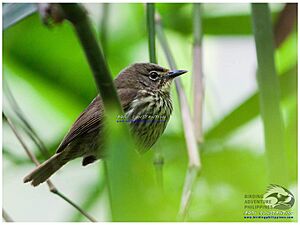Luzon striped babbler facts for kids
Quick facts for kids Luzon striped babbler |
|
|---|---|
 |
|
| Conservation status | |
| Scientific classification | |
| Genus: |
Zosterornis
|
| Species: |
striatus
|
| Synonyms | |
|
Stachyris striatus |
|
The Luzon striped babbler (Zosterornis striatus) is a special kind of bird. It belongs to the Zosteropidae family. This bird lives only in the Philippines. You can find it in northern Luzon and in Bataan.
Its natural home is in warm, wet tropical moist lowland forests. Sadly, its home is shrinking because of habitat loss.
What Does the Luzon Striped Babbler Look Like?
This bird is quite small. It has reddish-brown wings, back, and tail. Its head is gray. The underside of its body is pale with many streaks. It also has a black face and a black stripe that looks like a mustache.
Luzon striped babblers often join groups of different bird species. They look a bit like the Stripe-headed rhabdornis and Grand rhabdornis. But the babbler is smaller. It also has a white ring around its eye, not a black band. Its voice includes a loud, rattling sound. It also makes quiet chips and squeals.
Where Does the Luzon Striped Babbler Live?
This bird lives in forests and overgrown areas on Luzon. You can find it in lowlands and on hills. It can even live in forests that have been damaged. It also lives in areas where trees have been cut down but are now growing back.
The Luzon striped babbler mostly stays on the forest floor. It also likes the lower parts of the trees. Sometimes, it goes higher up into the middle or top parts of the trees. It usually lives in forests below 500 meters (about 1,640 feet). But in the Sierra Madre mountains, it can be found up to 1,000 meters (about 3,280 feet).
Other striped babblers, like the Panay striped babbler, live in higher places. But the Luzon striped babbler prefers lower areas.
Is the Luzon Striped Babbler in Danger?
The IUCN (International Union for Conservation of Nature) says this bird is of "least concern." This means it's not in immediate danger of disappearing. However, its population is believed to be getting smaller.
The biggest threat to this bird is habitat loss. Forests are being cleared for logging. They are also being turned into farms. Mining activities also destroy their homes. All these things are happening where the Luzon striped babbler lives.
Right now, there are no special plans just for this bird. It does live in the Northern Sierra Madre Natural Park. This is a protected area. But even there, logging and hunting still happen. The rules are not always strictly followed.



